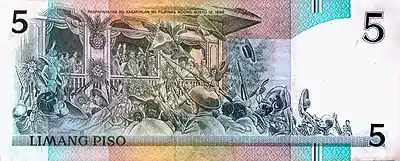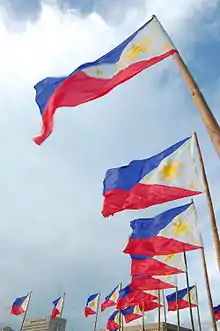Independence Day (Philippines)
Independence Day[1] (Filipino: Araw ng Kasarinlán; also known as Araw ng Kalayaan, "Day of Freedom") is an annual national holiday in the Philippines observed on June 12,[2] commemorating the declaration of Philippine independence from Spain in 1898.[2]
| Independence
Day Araw ng Kalayaan | |
|---|---|
.JPG.webp) Aguinaldo Shrine where Emilio Aguinaldo declared the country's independence from Spain | |
| Official name | Araw ng Kasarinlán |
| Also called | Araw ng Kalayaan |
| Observed by | Philippines |
| Type | National Day |
| Significance | Declaring Philippine independence from Spain |
| Date | June 12 |
| Next time | 12 June 2021 |
| Frequency | annual |
| Related to | Republic Day |
History


The earliest recorded was when Andres Bonifacio, along with Emilio Jacinto, Restituto Javier, Guillermo Masangkay, Aurelio Tolentino, Faustino Manalak, Pedro Zabala and few other Katipuneros went to Pamitinan Cave in Montalban, Rizal to initiate new members of the Katipunan. Bonifacio wrote Viva la independencia Filipina! or Long Live Philippine independence on walls of the cave to express the goal of their secret society.[3] Bonifacio also led the Cry of Pugad Lawin, which signals the beginning of Philippine Revolution. Members of the Katipunan, led by Bonifacio, tore their community tax certificates (cedulas personales) in protest of Spanish conquest.[4][5]
The Philippine Revolution began in 1896. The Pact of Biak-na-Bato, signed on December 14, 1897, established a truce between the Spanish colonial government and the Filipino revolutionaries. Under its terms, Emilio Aguinaldo and other revolutionary leaders went into exile in Hong Kong.[6]
At the outbreak of the Spanish–American War, Commodore George Dewey sailed from Hong Kong to Manila Bay leading the U.S. Navy Asiatic Squadron. On May 1, 1898, Dewey defeated the Spanish in the Battle of Manila Bay, which effectively put the U.S. in control of the Spanish colonial government. Later that month, the U.S. Navy transported Aguinaldo back to the Philippines.[7] Aguinaldo arrived on May 19, 1898 in Cavite.[8]
On June 5, 1898, Aguinaldo issued a decree at Aguinaldo house located in what was then known as Cavite El Viejo proclaiming June 12, 1898 as the day of independence. The Acta de la Proclamacion de la Independencia del Pueblo Filipino was solemnly read by its author, Ambrosio Rianzares Bautista, Aguinaldo's war counselor and special delegate.[9] The 21-page declaration was signed by 98 Filipinos, appointed by Aguinaldo, and one retired American artillery officer, Colonel L. M. Johnson.[10] The Philippine flag was officially unfurled for the first time at about 4:30 p.m, as the Marcha Nacional Filipina was played by the band of San Francisco de Malabon.[11]

The proclamation was initially ratified by 190 municipal presidents from the 16 provinces controlled by the revolutionary army August 1, 1898, and was again ratified on September 29, 1898 by the Malolos Congress.[12]
The Philippines failed to win international recognition of its independence, specifically including the United States of America and Spain. The Spanish government later ceded the Philippine archipelago to the United States in the 1898 Treaty of Paris. The Philippines Revolutionary Government did not recognize the treaty and the two sides subsequently fought what was known as the Philippine–American War.[13][14]
The United States of America granted independence to the Philippines on July 4, 1946. In accordance with the Philippine Independence Act (more popularly known as the "Tydings–McDuffie Act"), President Harry S. Truman issued Proclamation 2695 of July 4, 1946 officially recognizing the independence of the Philippines.[15] On the same day, the Treaty of Manila was signed.[16]
July 4 was chosen as the date by the United States because it corresponds to the United States' Independence Day, and that day was observed in the Philippines as Independence Day until 1962. On May 12, 1962, President Diosdado Macapagal issued Presidential Proclamation No. 28, which declared June 12 a special public holiday throughout the Philippines, "... in commemoration of our people's declaration of their inherent and inalienable right to freedom and independence.[17]" On August 4, 1964, Republic Act No. 4166 renamed July 4 holiday as "Philippine Republic Day", proclaimed June 12 as "Philippine Independence Day", and enjoined all citizens of the Philippines to observe the latter with befitting rites.[18]
Flag Day

Prior to 1964, June 12 was observed as Flag Day in the country. In 1965, President Diosdado Macapagal issued Proclamation No. 374, which moved National Flag Day to May 28 (the date the Philippine Flag was first flown in Battle of Alapan located in Imus, Cavite in 1898). In 1994, President Fidel V. Ramos issued Executive Order No. 179, extending the celebration period from May 28 to Philippine Independence Day on June 12, ordering government departments, agencies, offices, government owned and controlled corporations, state agencies, and local government units, and even private establishments, to prominently display the National Flag in all public buildings, government institutions, and official residences during this period; ordering the Department of Education, in coordination with the private sector, non-government organizations, and socio-civic groups, to enjoin the prominent display of the National Flag in all public squares and, whenever practicable, in all private buildings and homes in celebration of national independence.[19][20]
Holiday customs
As required by law, the Flag of the Philippines, first flown on that day in 1898, is displayed in homes and establishments from as early as May 28, Flag Day, or on a selected date of May by the National Historical Commission of the Philippines, which serves as the organizer of the celebrations, to the 30th of the month.[21] Kawit, Cavite holds a yearly commemorative act with the flag raising at the Aguinaldo Shrine and the reading of the Philippine Declaration of Independence.[22] Worldwide, Filipinos gather on June 12 or a date close to it to publicly celebrate, sometimes with a parade.[23] There are also local celebrations as well, as well as a national celebration in Manila, the national capital, which in past years included a civil-military parade of uniformed organizations and public and private entitles, the last major parade was held in 2018 to mark the 120th year of nationhood.[24]
See also
- List of national independence days
- RP612fic – a social media event held every Philippine Independence Day since 2009
| Wikisource has original text related to this article: |
| Wikisource has original text related to this article: |
| Wikisource has original text related to this article: |
| Wikisource has original text related to this article: |
| Wikisource has original text related to this article: |
References
- President of the Philippines. "DECLARING THE REGULAR HOLIDAYS, SPECIAL (NON-WORKING) DAYS, AND SPECIAL HOLIDAY (FOR ALL SCHOOLS) FOR THE YEAR 2013". PROCLAMATION NO. 459. Official Gazette, Philippine National Government. Retrieved July 23, 2013.
- "LOOK: Google Doodle for Philippine Independence Day". Rappler. June 12, 2019.
- Philippine Revolution: The Making of a Nation : Papers from the Regional Conferences Held in Cebu City, Davao City, Baguio City, and Dapitan City. National Centennial Commission. 1999. p. 474. ISBN 978-971-92018-7-8. Retrieved July 7, 2013.
- Sichrovsky, Harry. "An Austrian Life for the Philippines:The Cry of Balintawak". Retrieved August 29, 2009.
- Ocampo, Ambeth R. (1995). Bonifacio's bolo. Anvil Pub. p. 8. ISBN 978-971-27-0418-5.
- Halstead, Murat (1898). The Story of the Philippines and Our New Possessions, Including the Ladrones, Hawaii, Cuba and Porto Rico. p. 126.
- Agoncillo, Teodor A. (1990). History of the Filipino people ([8th ed.]. ed.). Quezon City: Garotech. p. 157. ISBN 978-9718711064. Archived from the original on January 14, 2020. Retrieved November 10, 2019.
- Agoncillo, Teodor A. (1990). History of the Filipino people (8th ed.). Quezon City: Garotech. ISBN 978-9718711064.
- Kenneth E. Bauzon (November 11, 2019). Capitalism, The American Empire, and Neoliberal Globalization. Themes and Annotations from Selected Works of E. San Juan, Jr. p. 85. ISBN 9789813290808.
- Ambeth R. Ocampo (June 12, 2019). "The mysterious Colonel Johnson". The Philippine Daily Inquirer.
- Cecilio D. Duka (2008). Struggle for Freedom' 2008 Ed. p. 166. ISBN 9789712350450.
- "Archived copy" (PDF). Archived from the original (PDF) on March 4, 2016. Retrieved August 12, 2017.CS1 maint: archived copy as title (link)
- De Ojeda, Jaime. "The Spanish–American War of 1898: A Spanish View." Archived April 6, 2018, at the Wayback Machine Library of Congress: Hispanic Division.
- Koenig, Louis W. (1982). "The Presidency of William McKinley" Archived March 6, 2016, at the Wayback Machine by Lewis L. Gould: Review. Presidential Studies Quarterly, Vol. 12, No. 3: pg. 448.
- "Proclamation 2695 of July 4, 1946 "Independence of the Philippines"". National Archives. August 15, 2016. Archived from the original on August 9, 2019. Retrieved August 9, 2019.
- Treaty of General Relations Between the United States of America and the Republic of the Philippines. Signed at Manila, on 4 July 1946 (PDF), United Nations, archived from the original (PDF) on July 23, 2011, retrieved December 10, 2007
- "Proclamation No. 28, s. 1962". Official Gazette of the Government of the Philippines. May 12, 1962. Retrieved September 3, 2015.
- AN ACT CHANGING THE DATE OF PHILIPPINE INDEPENDENCE DAY FROM JULY FOUR TO JUNE TWELVE, AND DECLARING JULY FOUR AS PHILIPPINE REPUBLIC DAY, FURTHER AMENDING FOR THE PURPOSE SECTION TWENTY-NINE OF THE REVISED ADMINISTRATIVE CODE, Chanrobles Law Library, August 4, 1964, archived from the original on August 15, 2009, retrieved November 11, 2009
- The Flag Days: May 28 to June 12 Archived August 12, 2014, at the Wayback Machine, May 27, 2014, Official Gazette of the Philippine Government,
- Executive Order No. 179, s. 1994 , May 24, 1994, Official Gazette of the Philippine Government.
- "National Flag Day". Manila Bulletin News. May 27, 2018. Archived from the original on November 11, 2018. Retrieved November 11, 2018.
- Legaspi, Amita (June 12, 2018). "Duterte leads Independence Day rites for the first time since becoming President". GMA News Online. Archived from the original on November 11, 2018. Retrieved November 11, 2018.
- "Manila Mail Exclusive: New York City Rejects Philippine Independence Day Parade Discrimination Claim". Manila Mail US. September 20, 2018.
- https://www.youtube.com/watch?v=rrLp638ZxBE